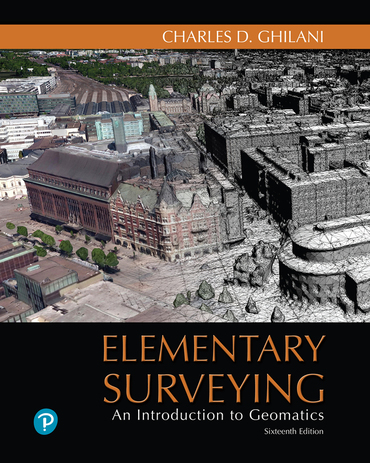Elementary Surveying An Introduction to Geomatics 16th Edition Charles D. Ghilani
Original price was: $50.00.$39.97Current price is: $39.97.
Format: Downloadable ZIP File
Resource Type: Test bank
Duration: Unlimited downloads
Delivery: Instant Download
Elementary Surveying: An Introduction to Geomatics 16th Edition by Charles D. Ghilani provides a comprehensive overview of fundamental concepts in modern surveying practice. This book covers a wide range of topics essential for surveyors and individuals preparing for licensing examinations. With over 400 figures and illustrations, the 16th edition offers a clear and detailed explanation of surveying tools and procedures.
The latest edition of Elementary Surveying: An Introduction to Geomatics includes updated discussions on surveying instruments, such as GNSS (Global Navigation Satellite Systems) for precise point positioning, small unmanned aerial systems for aerial surveys, new datums, and more. The end-of-chapter problems have been rewritten to illustrate computational procedures effectively.
Table of Contents:
– Introduction: Defines surveying, geomatics, and the history of surveying
– Units, Important Figures, and Field Notes
– Concept of Errors in Observations
– Leveling – Theory, Methods, and Equipment
– Leveling – Field Procedures and Computations
– Distance Measurement Techniques and Tools
– Angles, Azimuths, and Bearings
– Full Station Devices and Angle Observations
– Traversing Techniques
– Traverse Computations and Coordinate Geometry
– And much more
Whether you are a student studying surveying or a professional looking to enhance your knowledge, Elementary Surveying: An Introduction to Geomatics 16th Edition is a valuable resource that covers key principles and practices in the field of surveying.
FAQs:
Q: Is Elementary Surveying: An Introduction to Geomatics suitable for self-study?
A: Yes, this book is ideal for self-study due to its comprehensive coverage and clear explanations accompanied by figures and illustrations.
Q: Does the 16th edition cover the latest surveying technologies?
A: Yes, the 16th edition includes updated discussions on surveying instruments and procedures, including GNSS, unmanned aerial systems, and new datums.
Q: Does the book provide practical exercises for readers to apply what they have learned?
A: Yes, the book includes extensive end-of-chapter problems that offer opportunities for readers to practice and apply the concepts covered in each chapter.
Q: Who can benefit from reading Elementary Surveying: An Introduction to Geomatics?
A: The book is beneficial for students studying surveying, professionals in the surveying field, and individuals preparing for licensing examinations.
In conclusion, Elementary Surveying: An Introduction to Geomatics 16th Edition is a valuable resource that provides a solid foundation in surveying principles and practices. With its updated content and focus on modern surveying technologies, this book is a must-have for anyone seeking to enhance their knowledge in the field of geomatics and surveying.Surveying and mapping play a crucial role in various industries, including construction, land development, navigation, and more. These disciplines involve the measurement, analysis, and representation of the earth’s surface and its features. In the field of surveying, professionals use specialized equipment and techniques to gather data on landforms, boundaries, and other geographical elements. Mapping, on the other hand, focuses on creating accurate representations of the surveyed data using tools like Geographic Information Systems (GIS) and Computer-Aided Design (CAD). Let’s delve deeper into the various topics covered in surveying and mapping:
### 11.5 Intersection of a Line with a Circle
This section deals with the mathematical concept of finding the intersection points of a line with a circle. Understanding this intersection is crucial for determining positions and boundaries on maps and plans.
### 12.1 Area
Measuring and calculating areas of parcels, lands, and geographical features is essential for various purposes, such as land development, urban planning, and environmental assessment. Different methods, including division into simple figures and offsets from straight lines, are used to determine accurate areas.
### 13.1-15.12 World Navigation Satellite Systems
These sections provide an in-depth overview of GPS, satellite positioning, errors in observations, differential positioning, kinematic surveys, and more. Satellite technology has revolutionized surveying and mapping by enabling precise and efficient data collection in various environments.
### 16.1-16.14 Modifications by Least Squares
The concept of least squares adjustment is fundamental in surveying to minimize errors and improve the accuracy of measurements. Understanding how to apply least squares in adjustments and computations is crucial for producing reliable survey data.
### 17.1-17.16 Mapping Surveys
Mapping surveys involve the creation of detailed maps and elevation models of terrains, water bodies, and other features. Techniques like laser scanning, contouring, and digital modeling are used to generate accurate representations for different applications.
### 18.1-18.19 Mapping
Map design and production are key components of the mapping process. From data collection to drafting and plotting, various steps are involved in creating informative and visually appealing maps that serve different purposes.
### 19.1-19.19 Management Surveys and Geodetic Reductions
Managing survey data and applying geodetic principles are critical for ensuring accuracy and consistency in spatial measurements. Understanding reference frames, coordinate transformations, and error reduction techniques is essential for reliable survey results.
### 20.1-20.15 State Plane Coordinates and Map Projections
Map projections and coordinate systems are used to represent the earth’s surface on flat maps. State plane coordinates and other projections help facilitate accurate measurements and location-based information for surveying and mapping projects.
### 21.1-21.15 Boundary Surveys
Boundary surveys involve defining property lines, easements, and legal boundaries using various methods like metes and bounds, block-and-lot systems, and coordinates. Accurate boundary surveys are essential for land ownership, development, and legal purposes.
### 22.1-22.24 Surveys of the Public Lands
Public land surveys are conducted to establish boundaries, sections, townships, and subdivisions for government, conservation, and development purposes. These surveys follow specific guidelines and standards to ensure accuracy and consistency in land management.
### 23.1-23.9 Growth Surveys
Growth surveys focus on stakeouts and measurements for construction projects like pipelines, buildings, and highways. Precise horizontal and vertical control is essential for ensuring the proper alignment and positioning of structures in development.
Surveying and mapping are dynamic fields that continue to evolve with advancements in technology and techniques. Professionals in these disciplines play a vital role in shaping our understanding of the earth’s surface and its features.
### FAQs
#### 1. What is the intersection of a line with a circle?
The intersection of a line with a circle is a mathematical concept used to determine the points where a line and a circle meet. This calculation is essential in surveying for locating positions accurately.
#### 2. Why is least squares adjustment important in surveying?
Least squares adjustment minimizes errors in survey measurements and computations, leading to more precise and reliable survey data. It helps improve the overall accuracy of surveying projects.
#### 3. How do map projections impact surveying and mapping?
Map projections convert the three-dimensional surface of the earth into a two-dimensional representation for mapping purposes. Different projections have advantages and limitations that can affect the accuracy and visual appearance of maps.
#### 4. What are some common sources of error in boundary surveys?
Errors in boundary surveys can arise from factors like inaccurate measurements, ambiguous property descriptions, outdated records, or natural changes in the landscape. Proper survey techniques and documentation are essential for minimizing errors.
#### 5. How do growth surveys contribute to construction projects?
Growth surveys provide crucial data for staking out and setting grades for construction activities like pipelines, buildings, and highways. Accurate surveying ensures that structures are built according to the specified designs and requirements.
### Conclusion
Surveying and mapping are foundational disciplines that support a wide range of industries and applications. By employing advanced technologies and precise methodologies, surveyors and mappers help gather accurate spatial data, create informative maps, and facilitate informed decision-making in various fields. Continuous advancements in surveying and mapping techniques will further enhance the accuracy and efficiency of spatial data collection and representation for future projects and developments.Civil engineering professionals and students often rely on Test Banks for additional study material to enhance their understanding of complex subjects. Topics covered in Test Banks range from growth surveys using advanced equipment to detailed procedures for curve construction and calculations. The content is designed to provide comprehensive information on various civil engineering concepts and techniques, making it a valuable resource for both learners and practitioners in the field.
FAQs
Q: What are Test Banks?
A: Test Banks are supplemental study materials that provide a compilation of questions, answers, and explanations related to specific academic subjects or textbooks.
Q: How can Test Banks help with civil engineering studies?
A: Test Banks can assist civil engineering students in reinforcing their understanding of key concepts, practicing problem-solving techniques, and preparing for exams.
Q: Are Test Banks suitable for self-study?
A: Yes, Test Banks can be used for self-study purposes to review and test one’s knowledge on various topics in civil engineering.
Q: Where can I find Test Banks for civil engineering subjects?
A: Test Banks for civil engineering topics are often available online through academic resources, publishers, and educational platforms.
Conclusion
In conclusion, Test Banks serve as a valuable tool for individuals seeking to deepen their knowledge and skills in civil engineering. By delving into topics such as growth surveys, curve construction, volumes, photogrammetry, and geographic information systems, users can gain a comprehensive understanding of the subject matter. Whether you are a student looking to ace your exams or a professional aiming to enhance your expertise, Test Banks offer a convenient and effective way to supplement your learning journey in the field of civil engineering.
User Reviews
Be the first to review “Elementary Surveying An Introduction to Geomatics 16th Edition Charles D. Ghilani”

Original price was: $50.00.$39.97Current price is: $39.97.






There are no reviews yet.